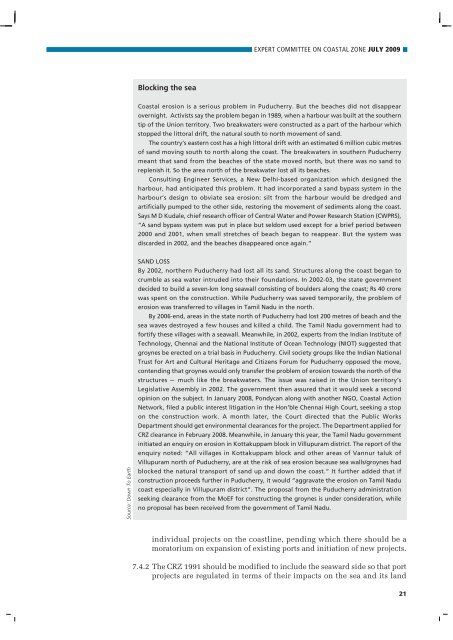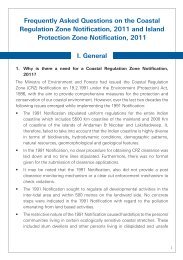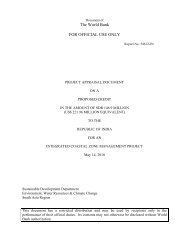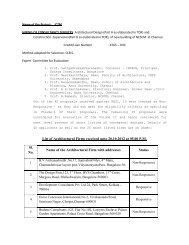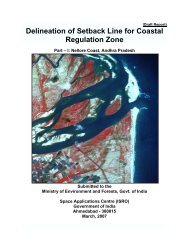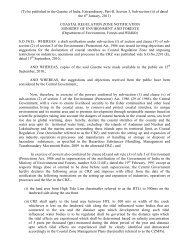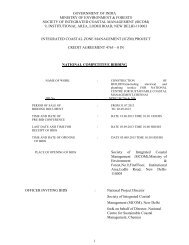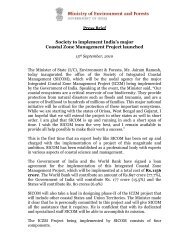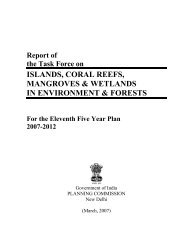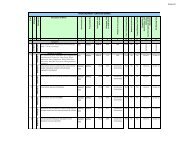FINAL FRONTIER Agenda to protect the ecosystem and ... - Sicom
FINAL FRONTIER Agenda to protect the ecosystem and ... - Sicom
FINAL FRONTIER Agenda to protect the ecosystem and ... - Sicom
Create successful ePaper yourself
Turn your PDF publications into a flip-book with our unique Google optimized e-Paper software.
EXPERT COMMITTEE ON COASTAL ZONE JULY 2009<br />
Blocking <strong>the</strong> sea<br />
Coastal erosion is a serious problem in Puducherry. But <strong>the</strong> beaches did not disappear<br />
overnight. Activists say <strong>the</strong> problem began in 1989, when a harbour was built at <strong>the</strong> sou<strong>the</strong>rn<br />
tip of <strong>the</strong> Union terri<strong>to</strong>ry. Two breakwaters were constructed as a part of <strong>the</strong> harbour which<br />
s<strong>to</strong>pped <strong>the</strong> lit<strong>to</strong>ral drift, <strong>the</strong> natural south <strong>to</strong> north movement of s<strong>and</strong>.<br />
The country’s eastern cost has a high lit<strong>to</strong>ral drift with an estimated 6 million cubic metres<br />
of s<strong>and</strong> moving south <strong>to</strong> north along <strong>the</strong> coast. The breakwaters in sou<strong>the</strong>rn Puducherry<br />
meant that s<strong>and</strong> from <strong>the</strong> beaches of <strong>the</strong> state moved north, but <strong>the</strong>re was no s<strong>and</strong> <strong>to</strong><br />
replenish it. So <strong>the</strong> area north of <strong>the</strong> breakwater lost all its beaches.<br />
Consulting Engineer Services, a New Delhi-based organization which designed <strong>the</strong><br />
harbour, had anticipated this problem. It had incorporated a s<strong>and</strong> bypass system in <strong>the</strong><br />
harbour’s design <strong>to</strong> obviate sea erosion: silt from <strong>the</strong> harbour would be dredged <strong>and</strong><br />
artificially pumped <strong>to</strong> <strong>the</strong> o<strong>the</strong>r side, res<strong>to</strong>ring <strong>the</strong> movement of sediments along <strong>the</strong> coast.<br />
Says M D Kudale, chief research officer of Central Water <strong>and</strong> Power Research Station (CWPRS),<br />
“A s<strong>and</strong> bypass system was put in place but seldom used except for a brief period between<br />
2000 <strong>and</strong> 2001, when small stretches of beach began <strong>to</strong> reappear. But <strong>the</strong> system was<br />
discarded in 2002, <strong>and</strong> <strong>the</strong> beaches disappeared once again.”<br />
Source: Down To Earth<br />
SAND LOSS<br />
By 2002, nor<strong>the</strong>rn Puducherry had lost all its s<strong>and</strong>. Structures along <strong>the</strong> coast began <strong>to</strong><br />
crumble as sea water intruded in<strong>to</strong> <strong>the</strong>ir foundations. In 2002-03, <strong>the</strong> state government<br />
decided <strong>to</strong> build a seven-km long seawall consisting of boulders along <strong>the</strong> coast; Rs 40 crore<br />
was spent on <strong>the</strong> construction. While Puducherry was saved temporarily, <strong>the</strong> problem of<br />
erosion was transferred <strong>to</strong> villages in Tamil Nadu in <strong>the</strong> north.<br />
By 2006-end, areas in <strong>the</strong> state north of Puducherry had lost 200 metres of beach <strong>and</strong> <strong>the</strong><br />
sea waves destroyed a few houses <strong>and</strong> killed a child. The Tamil Nadu government had <strong>to</strong><br />
fortify <strong>the</strong>se villages with a seawall. Meanwhile, in 2002, experts from <strong>the</strong> Indian Institute of<br />
Technology, Chennai <strong>and</strong> <strong>the</strong> National Institute of Ocean Technology (NIOT) suggested that<br />
groynes be erected on a trial basis in Puducherry. Civil society groups like <strong>the</strong> Indian National<br />
Trust for Art <strong>and</strong> Cultural Heritage <strong>and</strong> Citizens Forum for Puducherry opposed <strong>the</strong> move,<br />
contending that groynes would only transfer <strong>the</strong> problem of erosion <strong>to</strong>wards <strong>the</strong> north of <strong>the</strong><br />
structures – much like <strong>the</strong> breakwaters. The issue was raised in <strong>the</strong> Union terri<strong>to</strong>ry’s<br />
Legislative Assembly in 2002. The government <strong>the</strong>n assured that it would seek a second<br />
opinion on <strong>the</strong> subject. In January 2008, Pondycan along with ano<strong>the</strong>r NGO, Coastal Action<br />
Network, filed a public interest litigation in <strong>the</strong> Hon’ble Chennai High Court, seeking a s<strong>to</strong>p<br />
on <strong>the</strong> construction work. A month later, <strong>the</strong> Court directed that <strong>the</strong> Public Works<br />
Department should get environmental clearances for <strong>the</strong> project. The Department applied for<br />
CRZ clearance in February 2008. Meanwhile, in January this year, <strong>the</strong> Tamil Nadu government<br />
initiated an enquiry on erosion in Kottakuppam block in Villupuram district. The report of <strong>the</strong><br />
enquiry noted: “All villages in Kottakuppam block <strong>and</strong> o<strong>the</strong>r areas of Vannur taluk of<br />
Villupuram north of Puducherry, are at <strong>the</strong> risk of sea erosion because sea walls/groynes had<br />
blocked <strong>the</strong> natural transport of s<strong>and</strong> up <strong>and</strong> down <strong>the</strong> coast.” It fur<strong>the</strong>r added that if<br />
construction proceeds fur<strong>the</strong>r in Puducherry, it would “aggravate <strong>the</strong> erosion on Tamil Nadu<br />
coast especially in Villupuram district”. The proposal from <strong>the</strong> Puducherry administration<br />
seeking clearance from <strong>the</strong> MoEF for constructing <strong>the</strong> groynes is under consideration, while<br />
no proposal has been received from <strong>the</strong> government of Tamil Nadu.<br />
individual projects on <strong>the</strong> coastline, pending which <strong>the</strong>re should be a<br />
mora<strong>to</strong>rium on expansion of existing ports <strong>and</strong> initiation of new projects.<br />
7.4.2 The CRZ 1991 should be modified <strong>to</strong> include <strong>the</strong> seaward side so that port<br />
projects are regulated in terms of <strong>the</strong>ir impacts on <strong>the</strong> sea <strong>and</strong> its l<strong>and</strong><br />
21


